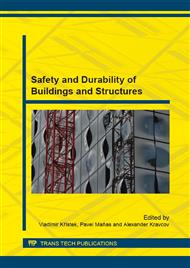p.43
p.53
p.69
p.77
p.85
p.91
p.99
p.111
p.119
Damage Evolution of Concrete by Electrical Resistivity Monitoring Methods
Abstract:
The leaching behavior of hydraulic concrete can’t be neglected for its long-term exposure to surrounding water resulting in irreversible damage to durability, such as strength loss and porosity increase. Given that the coupling effect of leaching and freeze-thaw cycling on the durability of hydraulic concrete especially in severe cold regions is a big challenge. For the quite slow process of natural leaching, electrochemical accelerated leaching method (EALM) was proposed to investigate the damage evolution under two test schemes (scheme one is only leaching for 50 days and scheme two is first 100 rapid freeze-thaw cycles and then leaching for 50 days) designed in this work. The electrical resistivity and calcium oxide dissolution mass were measured through electrochemical impedance spectroscopy (EIS), namely two-probe method, and EDTA titration method, respectively. Based on electrical resistivity measurement, the measurable damage can be discussed during abovementioned singe and coupled tests. The results indicate that compared with single leaching test, the leaching coupled with the freeze-thaw cycling leads to over 50% electrical resistance loss.
Info:
Periodical:
Pages:
85-89
Citation:
Online since:
October 2015
Authors:
Price:
Сopyright:
© 2015 Trans Tech Publications Ltd. All Rights Reserved
Share:
Citation:


